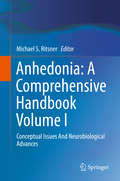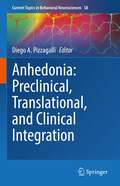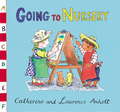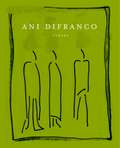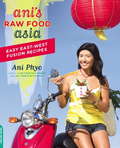- Table View
- List View
Angus, Tootallo and the Fairies
by Billie CookAngus and his dog Tootallo know there are fairies and other wee people. One day, they dance in the open air to make the fairies know it will be safe to appear. The reason they do this is because a doctor, newly arrived in the area, wants to find the little people so he can be their doctor. Will he achieve this, and if he does, what surprises might await him in the future? Angus, Tootallo and the Fairies is a delightful story for children.
Angélica and la Güira
by Angie CruzA young girl harnesses the power of music to bridge the distance between the Dominican Republic and Washington Heights in this jubilant picture book debut by Angie Cruz, bestselling and award-winning author of Dominicana.Angélica has spent the summer in the Dominican Republic with her tías and primas, her grandparents, and their parrot, but soon she&’ll have to say goodbye. The end of summer means returning home to start school on another shore. Before she leaves, her grandfather gives her the perfect gift. It's something with the power to make people dance as fast as the wings of a hummingbird: a güira. Angélica falls in love with this musical instrument, though nobody shares her enthusiasm at first. &“What is that sound,&” they say, &“pennies inside a tin cup?&” But on a hot, sunny day, in the land of Washington Heights, where the frío frío woman scrapes ice for a long line of customers and the men on the corner plunk dominoes on a makeshift carboard table, Angélica shows her neighbors the power of la güira. Angélica and la Güira lovingly explores music and community, the wisdom and guidance of our elders, and the joy and freedom of dancing in the street. No matter where we are, music brings us closer to home. Don't miss the Spanish-language edition of this book, Angélica y la güira.
Angéline de Montbrun: A Psychological Romance of Quebec
by Laure Conan Yves BrunelleLaure Conan was the first woman novelist in French Canada and the first writer in all Canada to attempt a roman d'analyse. As she refused to have her true identity revealed, the author of the preface to her book, Abbé H.-R. Casgrain, made a point of confirming that it was indeed a woman hiding behind the pen-name. Her daring in writing a psychological novel was 'forgiven' because she was a woman, and her anticipating the trend towards this type of novel was attributed to 'that intuition natural to her sex.' In Angéline de Montbrun, Laure Conan broke with what has been called the 'collective romanticism' of nineteenth-century French-Canadian land, with the rural myth, the exhortative tone, and the vast canvas. These concerns are basically absent in her work. Further, she eschewed the details of adventure and intrigue, the wooden, predictable characters, and the transparent intricacies of romantic love in favour of writing about the inner turmoil of an individual, live character, a young woman caught in a complex web of human appetites, aspirations, and relationships. Because of the novel's realism, one of the most persistent topics of discussion about Laure Conan has been whether or not Angéline de Montbrun is autobiographical. Recent studies indicate it may be. In any case, Angéline was the most complex character in Canadian fiction to 1882 and for some time to come. Traditionally, Angéline de Montbrun was regarded as a novel of Christian renunciation, and Angéline as the most holy of heroines. For a long time no one went too deeply into the relationships between the characters, but in 1961 Jean Le Moyne bluntly stated that 'the lovers in the novel are not Maurice Darville and Angéline, but M. de Montbrun and his daughter.' Since then there has been a proliferation of interpretations and psychological studies of the novel, and there is no going back to the simpler view of it.
Angélique
by Guillaume MussoThe new thriller from #1 international bestselling author Guillaume Musso.PARIS, CHRISTMAS 2021. After a heart attack, Mathias Taillefer wakes up in the hospital with a stranger at his bedside. The mysterious girl reveals herself to be Louise Collange, a volunteer who has come to play the cello for patients. When she finds out that Mathias is a cop, she asks him to look into a very special case. Her mother, a former ballerina at the Paris Opera Ballet, died last year after falling from her balcony, and Louise has a hunch she was pushed. Though hesitant at first, Mathias agrees to help her, sending them both headfirst into a deadly chain of events. And at the centre of it all, a woman named Angélique, whose angelic intentions may not be all they seem. Feverous, surprising and uplifting, Musso's newest novel is a labyrinth of emotions where nothing is certain from one page to the next.
Angélique
by Lorena Gale"And in seventeen thirty-four a Negro slave set fire to the City of Montreal and was hanged..." With this bald statement of history as a basis, Lorena Gale constructs a vivid portrait of a time when captive people had no say in the outcome of their lives. A rich, poetic evocation of a graceful yet cruel time—a time when “civilized” citizens still bought and sold slaves. This is a time when the thoughts and feelings of these captive people had no bearing on the outcome of their lives, unless they were outraged and brave enough to try and shake their bonds. Angélique is the winner of the du Maurier National Playwriting Competition and was nominated Outstanding New Play in Calgary’s Betty Mitchell Awards, 1998.
Angélique: From the No.1 International Thriller Sensation
by Guillaume MussoEVEN ANGELS HAVE THEIR DEMONS . . .PARIS, CHRISTMAS 2021. After a heart attack, Mathias Taillefer wakes up in hospital with a stranger at his bedside. The mysterious girl reveals herself to be Louise Collange, a volunteer who has come to play the cello for patients. When she finds out Mathias is a cop, she asks him to take charge of a very special case. Her mother, a former ballerina at the Paris Opera Ballet, died last year after falling from her balcony, and Louise has a hunch she was pushed. Though hesitant at first, Mathias agrees to help her, sending them both headfirst into a deadly chain of events. And at the centre of it all, a woman named Angélique, whose angelic intentions may not be all they seem . . .Feverous, surprising and uplifting, Musso's newest novel is a labyrinth of emotions where nothing is certain from one page to the next.PRAISE FOR THE ICONIC BESTSELLER GUILLAUME MUSSO:'THE FRENCH SUSPENSE KING' NEW YORK TIMES'ONE OF THE GREAT THRILLER WRITERS OF OUR AGE' DAILY EXPRESS'THE KING OF EUROPEAN NOIR' LA REPUBBLICA, ITALY'IT'S NO WONDER THAT GUILLAUME MUSSO IS ONE OF FRANCE'S MOST LOVED, BESTSELLING AUTHORS' HARLAN COBEN
Anh's Anger: An Anh's Anger Story (Anh's Anger Story)
by Christiane Krömer Gail SilverChildren experience anger on a regular basis, but lack the coping skills to guide them through these difficult moments. In Anh's Anger, five-year-old Anh becomes enraged when his grandfather interrupts playtime with a summons to the dinner table. When Anh's grandfather takes the time to help Anh fully experience his anger by suggesting he go to his room and "sit with his anger," Anh discovers a positive method by which to work through his feelings. This remarkable book teaches children to both acknowledge and resolve their difficult emotions, making it an invaluable tool for parents and teachers alike.
Anhedonia: Conceptual Issues And Neurobiological Advances
by Michael S. RitsnerThis is the first comprehensive two-volume collection on anhedonia, a disorder that played an important role in psychopathology theories at the beginning of the twentieth century. Anhedonia is a condition in which the capacity of pleasure is partially or completely lost, and it refers to both a personality trait, and a "state symptom" in various neuropsychiatric and physical disorders. It has a putative neural substrate, originating in the dopaminergic mesolimbic and mesocortical reward circuit. Over the past three decades cognitive psychology and behavioral neuroscience have expanded our understanding of anhedonia and other reward-related processes. The aim of this new two-volume collection on anhedonia is to highlight the contributions of eminent scientists in this field as well as to provide readers with comprehensive accounts of recent developments as perceived by the authors. This monograph is divided into five parts. Volume I contains parts one and two (Conceptual Issues and Neurobiological Advances) including 14 chapters that serve as an introduction and overview of conceptual issues. Volume II contains three parts (Anhedonia in Psychotic Disorders, Anhedonia in Mood and Personality Disorders, and Anhedonia in Neurological and Physical Disorders) including 15 chapters that provide an overview of the construct, measurement of anhedonia in schizophrenia spectrum disorders, hedonic capacity and related factors in schizophrenia and schizoaffective disorder, anhedonia as an indicator of genetic liability for schizophrenia, and as a trait marker for depression, the role of an anhedonia in trauma-related disorders, anorexia nervosa, stress-induced eating disorders, schizotypal traits and risk of suicide. This book will be of interest to a broad spectrum of readers including psychiatrists, psychologists, neurologists, neuroscientists, endocrinologists, pharmacologists, general practitioners, geriatricians, graduate students, and health care providers in the fields of mental health.
Anhedonia: Preclinical, Translational, and Clinical Integration (Current Topics in Behavioral Neurosciences #58)
by Diego A. PizzagalliAnhedonia is a key symptom (and often risk factor) for various neuropsychiatric disorders, including depression, schizophrenia, substance use disorders, post-traumatic stress disorders, and Parkinson's Disease, among others. Across disorders, anhedonia has been associated with worse disease course, including poor response to pharmacological, psychological and neurostimulation treatments as well as completed suicide. Mounting evidence emerging from preclinical and translational sciences has clarified that "anhedonia" can be parsed into partially independent subcomponents, including incentive motivation, consummatory pleasure, reward learning, and effort-based decision making, pointing to distinct neurobiological substrates that could underlie anhedonic phenotypes. Taking an integrative approach that emphasizes cross-species integration and dimensional conceptualization of mental illnesses (e.g., Research Domain Criteria (RDoC)), this book represents the most comprehensive evaluation, synthesis and integration of theories and empirical findings focused on anhedonia.Organized across five parts, the handbook starts with chapters on the history, etiology, and assessments of anhedonia (Part I), followed by a section on the role of anhedonia in psychiatric and neurological disorders (Part II). Using the RDoC Matrix as a guide, Part III presents chapters synthetizing preclinical and clinical findings on different reward processing subdomains (e.g., reward responsiveness, reward valuation, reward learning). Part IV is focused on selected special topics, including historical and current perspectives on the transdiagnostic nature and importance of social anhedonia, the role of inflammation in the pathophysiology of anhedonia, the use of computational modeling to “dissect” anhedonia and improve its understanding, and links between anhedonia and suicide. Finally, Part V includes chapters on pharmacological, psychological and neurostimulation treatments for anhedonia.
Anheuser-Busch and Campbell Taggart
by Erik Sirri Jonathan ShakesIn 1984, the SEC accused Paul Thayer and eight others of insider trading. Some of Thayer's inside information came from his position on the board of Anheuser-Busch, where he had learned about Busch's 1982 merger with Campbell Taggart before the merger was publicly announced. The case deals with Busch's reaction after learning about the SEC suit. In considering possible actions by Busch, students may explore the workings of capital markets and attempt to estimate the amount of financial damage done to Busch by the insider trading. Other issues involve ethics, the allocation of management resources on costly legal battles, and the differing objectives of board members and managers.
Anheuser-Busch and the U.S. Brewing Industry
by Anita M. McgahanPresents an analytical report on the company's competitive position and on the industry structure in 1991. Used to show how a company can generate value through steady, incremental investment over a long period in a business model tailored to the industry context. Also illustrates the challenges of market leadership.
Anholt Family Favourites: Going to Nursery
by Laurence AnholtA reassuring picture book about starting nursery.Anna is a bit worried about starting nursery. She doesn't want to leave her mummy and she won't know anyone there ... But soon Anna is having lots of fun, painting, dressing up and playing with new friends!Starting nursery is an exciting but anxious time for every family, and sharing this book together is the perfect way to prepare for the big day. The simple, reassuring story covers meeting the teacher, snack-time, going to the loo, making friends and doing all sorts of fun activities. So your little one will know just what to expect on their first day.
Ani DiFranco: Verses
by Ani DifrancoWith eight Grammy nominations and sales of over 4.5 million, Ani DiFranco is one of America's most fiercely independent and beloved musicians, as well as an outspoken voice of conscience. For the first time, she releases a book of poetry and paintings, capturing her essential artistry that has helped define and invigorate a new generation. Ani DiFranco: Verses rages, eulogizes, menaces, revels, and envisions. With a poet's precision and a citizen's stake, DiFranco finds the meeting places of intimacy and politics, of self and country, of resolve and compromise, and of the fickle and magnificent capacities of love and solitude.
Ani Trime's Little Book of Affirmations: 52 Illustrated Practices for a Peaceful and Open Mind
by Ani Trime“Every thought I think is creating my future.” So begin the 52 affirmations of Ani Trime, a beloved teacher in the Tibetan Buddhist tradition who began her own life as a gruff, plainspoken West Virginian. Noted for her humor and no-nonsense approach to spiritual practice, Trime offers wise uplifting affirmations that will resonate with everyone. Collected in an appealing, pocket-size volume, Ani Trime’s Little Book of Affirmations features original illustrations created by 39 well-known contemporary commercial artists. This publication conforms to the EPUB Accessibility specification at WCAG 2.0 Level AA.
Ani's 15-Day Fat Blast
by Ani PhyoLooking for that one miracle diet that will simply melt pounds away? Here it is. Premiere raw food chef Ani Phyo breaks down the myths and preconceptions of eating raw and offers a revolutionary, easy plan to help you shed up to fifteen pounds in just fifteen days simply by eating delicious raw meals. The plan is simple: eat up and speed up the fat burning and weight loss by using simple, living, and all-natural ingredients with Ani’s signature recipes. Look forward to not only losing weight, but also building muscle, boosting endurance, slowing down aging, and feeling energized all day long.
Ani's 15-Day Fat Blast
by Ani PhyoFrom the author of "AniOCOs Raw Food Kitchen": an easy diet plan using raw foods for health, beauty, weight loss, and overall well-beinga"
Ani's Raw Food Asia: Easy East-West Fusion Recipes the Raw Food Way
by Ani PhyoYou've been to her kitchen, enjoyed her desserts, and mastered the essentials; now go with raw food goddess Ani Phyo back to her roots for the first ever Asian raw food cookbook. Along with recipes from Korea, China, Japan, Thailand, Vietnam, India, Indonesia, and Hawaii and background information on traditional dishes, Ani's Raw Food Asia also offers essential tips on green living, well-being, longevity, fitness, beauty, and entertaining as inspired by a healthy Asian lifestyle. Recipes include: Mixed Vegetable Skewers with Almond-Butter Sauce, Creamed Curry Saag, Vegetable Tempura with Orange Lemongrass Dipping Sauce, Marinated Shiitake Mushroom Dumplings, Corn Fritters with a Hot and Sour Cucumber Dipping Sauce, Dosas, Moo Shoo Vegetables, and more.
Ani's Raw Food Desserts: 85 Easy, Delectable Sweets and Treats
by Ani PhyoFrom the author of "AniOCOs Raw Food Kitchen"?a full-color, giftable collection of raw sweets and treats recipes, a la "Vegan Cupcakes Take Over the World""
Ani's Raw Food Detox [previously published as Ani's 15-Day Fat Blast]: The Easy, Satisfying Plan to Get Lighter, Tighter, and Sexier . . . in 15 Days or Less
by Ani PhyoWant to look younger and feel better?Want to increase your energy levels, build lean muscle, and enhance immunity?Want to do all this while eating delicious, easy meals that will leave you feeling satisfied and full of energy?Welcome to Ani's Raw Food Detox. Award-winning chef, health coach, and consultant Ani Phyo offers an easy, delicious 15-day program based on nature's real "fast foods." The plan is simple: eat up and speed up the cleansing, detoxing, and fat-burning process by using all-natural whole food ingredients. Watch the pounds fly off as you gain boundless energy and clear, radiant skin while at the same time lowering your risk for chronic diseases. Designed to help you get optimal results and achieve your detoxing and immune-boosting goals, Ani's Raw Food Detox offers:Top detox and fat-fighting strategies and toolsLists of foods that accelerate cleansing, detox, and your metabolismMore than 50 quick, easy, delicious recipesMenus and shopping lists for each phase of the planStrategies for long-term health and maintenance
Ani's Raw Food Essentials
by Ani PhyoChef Ani Phyo is back with Ani's Raw Food Essentials, full of everything you need to know to master the art of live food. Phyo shows you how to whip up simple, fresh recipes using what you've already got in your kitchen while also offering tips on dehyrating and more sophisticated techniques. Looking for innovative meals that are healthy and delicious? Phyo offers everything from classic comfort foods like nachos and burgers to Reuben sandwiches and bacon, along with more gourmet dishes like risotto, angel hair pasta, and her "you-won't-believe-they're-raw" desserts.Ani's Raw Food Essentials once again proves that you don't have to sacrifice taste to reap the benefits of raw foods, all while living a greener lifestyle. Recipes include: Broccoli and Cheeze Quiche, Kalamata Olive Crostini, Cashew "Tofu" in Miso Broth, Grilled Cheeze and Tomato Sandwiches, Cheeze Enchilada with Ranchero and Mole Sauce, Pad Thai, Pesto Pizza, and many more.
Ani's Raw Food Essentials
by Ani PhyoFrom the author of Ani's Raw Food Kitchen (over 45,000 copies sold) and Ani's Raw Food Desserts, comes the go-to book for all things raw.
Ani's Raw Food Essentials: Recipes and Techniques for Mastering the Art of Live Food
by Ani PhyoFrom the author of "AniOCOs Raw Food Kitchen" (over 45,000 copies sold) and "AniOCOs Raw Food Desserts," comes the go-to book for all things raw. "
Ani's Raw Food Kitchen: Easy, Delectable Living Foods Recipes
by Ani PhyoThis is the ultimate gourmet, living foods "uncookbook" for busy people. You don't have to sacrifice taste or style to reap the benefits of raw foods. These delectable, easy recipes emphasize fresh, animal-free ingredients and how to include more organics into your daily diet. Chef Ani offers delicious raw, animal-free versions of: breakfast scrambles, pancakes, chowders, bisques, and other soups, cheezes, mylks, lasagna, burgers, cobblers, pies, and cakes, and more. Included are recipes for dishes such as Stuffed Anaheim Chili with Mole Sauce, Ginger Almond Nori Roll, Coconut Kreme Pie with Carob Fudge on Brownie Crust, Mediterranean Dolmas, and Chicken-Friendly Spanish Scramble. Make your own kitchen more living-foods friendly with Chef Ani's tips on Essential tools, Key ingredients, Stocking your pantry, and How-to kitchen skills.
Aniana del Mar Jumps In
by Jasminne MendezPura Belpré Author Honor Award** Four starred reviews!**A powerful and expertly told novel in verse about a twelve-year-old Dominican American swimmer who is diagnosed with Juvenile Arthritis by an award-winning poet.Aniana del Mar belongs in the water like a dolphin belongs to the sea. But she and Papi keep her swim practices and meets hidden from Mami, who has never recovered from losing someone she loves to the water years ago. That is, until the day Ani&’s stiffness and swollen joints mean she can no longer get out of bed, and Ani is forced to reveal just how important swimming is to her. Mami forbids her from returning to the water but Ani and her doctor believe that swimming along with medication will help Ani manage her disease. What follows is the journey of a girl who must grieve who she once was in order to rise like the tide and become the young woman she is meant to be. Aniana Del Mar Jumps In is a poignant story about chronic illness and disability, the secrets between mothers and daughters, the harm we do to the ones we love the most—and all the triumphs, big and small, that keep us afloat."Beautiful in its honesty and vulnerability, this is a powerful story about dreams and bodily agency that sings from the heart.&”—Natalia Sylvester, award-winning author of Breathe and Count Back From Ten
Aniela Kaminski's Story: A Voyage from Poland during World War II (Journey to America Series)
by Clare PastoreThey left their homelands during the worst moments in history and arrived in America ready to reach for their dreams. These are their stories... Dear Jadzia,I thought Papa and I would never make it out of Poland. I was afraid the Nazis would find us and send us to jail. After Stefan was arrested, I knew it could happen to us, too. Do you have any news of him? I hope and pray that he is safe. And Edith, too. It makes me angry to think that people hate her just because she is Jewish. You would love America. Life is so much better here. We are staying with my aunt and uncle in a city called Chicago, and there is lots of good food to eat. And guess what? I might even start taking piano lessons again! I wish you were here, Jadzia. I miss you so very much... Your friend, Aniela







